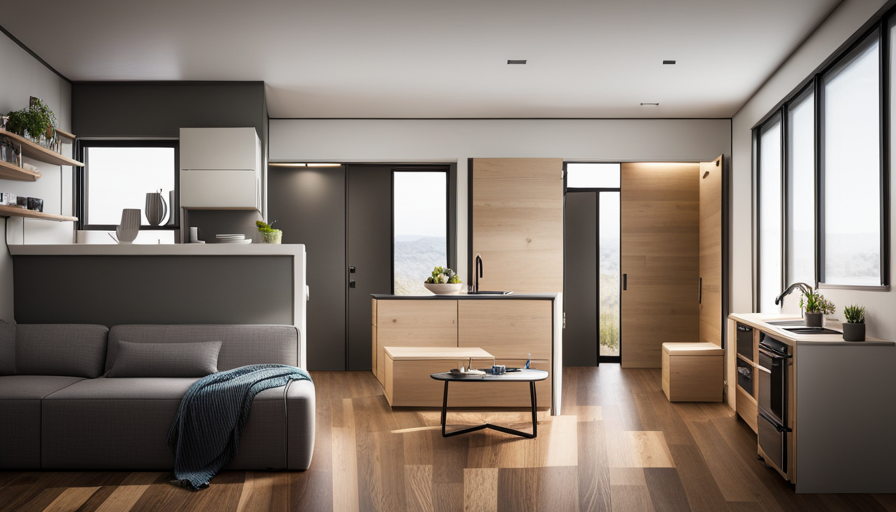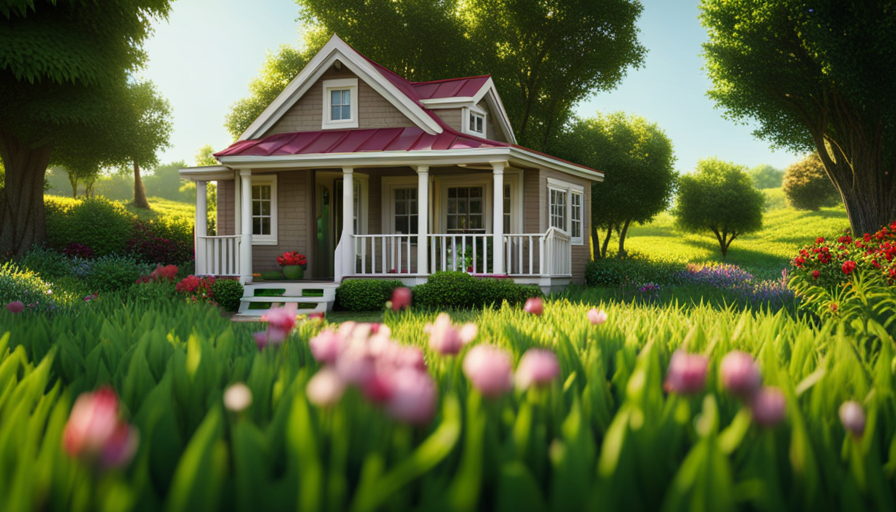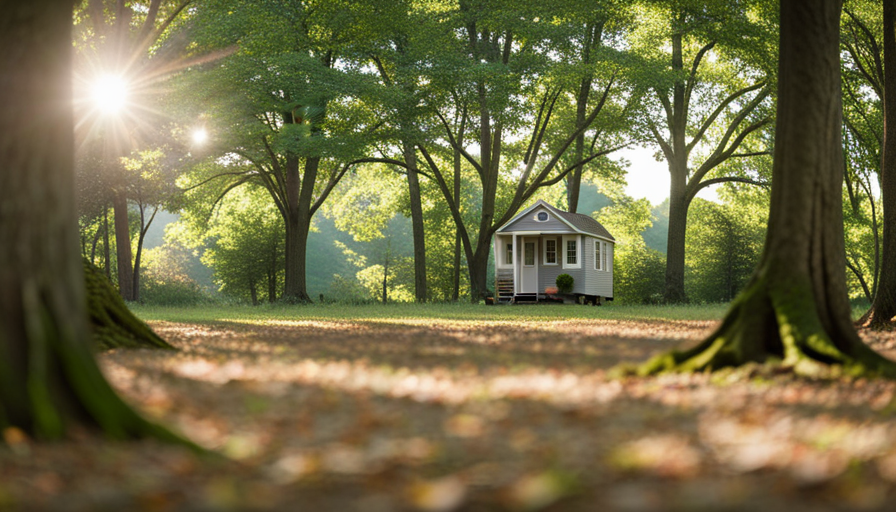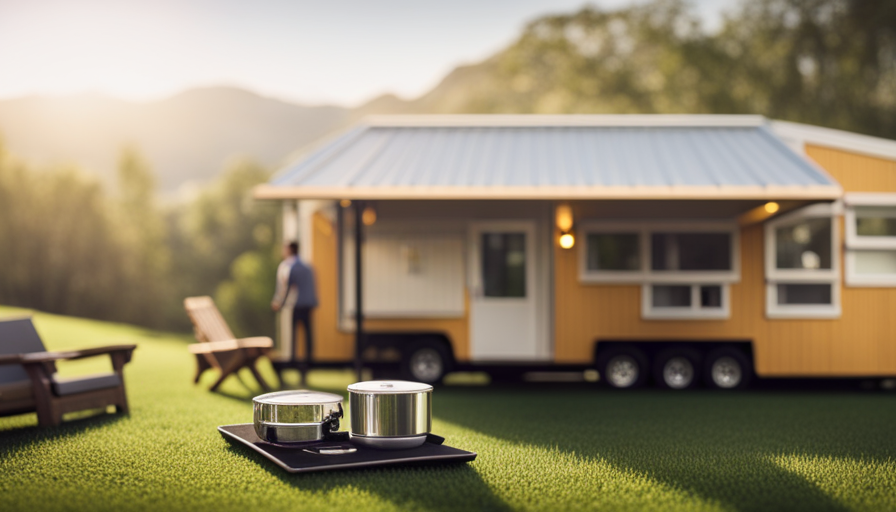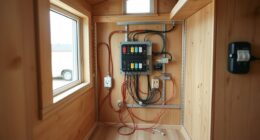As they say, ‘Good things come in small packages.’ This sentiment holds true, especially when it comes to housing. Tiny houses have gained popularity among those looking for a more minimalist and eco-friendly lifestyle. However, before starting your tiny house journey, it is crucial to understand where you are allowed to build one.
In this article, I will guide you through the process of finding the perfect location for your tiny dream home. From researching local zoning regulations to considering available land options, exploring tiny house-friendly communities to evaluating infrastructure and utilities, we will leave no stone unturned.
Whether you’re looking for a rural retreat or a spot within a bustling city, there are options available. So let’s dive in and discover where you can build your own little piece of paradise.
Key Takeaways
- Research local zoning regulations and permits to understand the legal considerations for building a tiny house.
- Consider different options for building a tiny house, such as urban areas, rural areas, backyard or accessory dwelling units, and tiny house communities.
- Seek resources and support from government initiatives, non-profit organizations, local experts, and tiny house advocacy groups.
- Explore funding options such as personal savings, loans, crowdfunding, grants, and sponsorships to finance the construction of a tiny house.
Research Local Zoning Regulations
You’ll need to research the local zoning regulations to find out where you can build your tiny house. Before you start planning, it’s important to understand the rules and requirements set by your local government. Researching local permits and understanding zoning laws will help ensure that you can legally build your tiny house in a suitable location.
First, you should research the specific requirements for tiny houses in your area. Some cities have specific regulations for tiny houses, while others may treat them as accessory dwelling units or mobile homes. It’s crucial to know the size limitations, setbacks, and other restrictions that may apply to your tiny house.
Additionally, you’ll want to check if there are any zoning restrictions that could impact where you can build. Zoning laws dictate how land can be used and can include residential, commercial, or industrial zones. Some areas may have zoning restrictions that prohibit tiny houses or limit them to specific zones.
Once you have researched the local zoning regulations and permits, you can consider available land options for building your tiny house. Transitioning into the next section, it’s important to explore different areas that align with the zoning regulations and can accommodate your tiny house.
Consider Available Land Options
Don’t limit yourself to traditional housing plots; there’s a whole world out there waiting for your pint-sized palace. When considering where to build your tiny house, it’s important to research land availability and consider the environmental impact. Here are some options to consider:
| Option | Description |
|---|---|
| Urban Areas | Look for vacant lots or underutilized spaces in urban areas. These locations often have existing infrastructure and amenities nearby. However, be mindful of zoning regulations and building codes. |
| Rural Areas | Explore rural areas where land is more abundant and regulations may be more lenient. This option allows for greater flexibility in terms of design and location, but make sure to consider access to utilities and services. |
| Backyard or Accessory Dwelling Unit (ADU) | Consider building your tiny house in a backyard or as an ADU on an existing property. This option allows for close proximity to family or friends and may have fewer restrictions. However, you’ll need to ensure compliance with local regulations. |
| Tiny House Communities | Look into tiny house-friendly communities that offer designated spaces for tiny homes. These communities often provide communal facilities and a supportive network of like-minded individuals. Research the rules and regulations of each community before making a decision. |
| Mobile Tiny Homes | Consider the option of a mobile tiny home, which allows you to travel and explore different areas while still having a place to call home. However, make sure to research local laws and regulations regarding parking and occupancy. |
As you research land availability and consider the environmental impact, it’s important to keep in mind that different locations offer different opportunities and challenges for building a tiny house. In the next section, we will look into tiny house-friendly communities and how they can provide a supportive environment for tiny house dwellers.
Look into Tiny House-Friendly Communities
When it comes to finding a place to build a tiny house, I’ve been exploring the option of tiny house-friendly communities. These communities not only provide a supportive environment for tiny house enthusiasts, but they also offer a range of amenities and resources that make tiny living even more convenient.
One key aspect of these communities is the opportunity to join existing tiny house communities, where like-minded individuals come together to create a close-knit community.
Additionally, co-housing and cooperative living options are worth considering, as they provide a sense of shared responsibility and a chance to collaborate with others in creating a sustainable and affordable living situation.
Find Existing Tiny House Communities
Discovering existing tiny house communities can be an exciting journey, as you’ll uncover unique and vibrant neighborhoods where like-minded individuals have come together to embrace the simplicity of tiny living. These communities offer a sense of belonging and a chance to connect with others who share a passion for sustainable living and minimalism.
-
Escape the city: Many existing tiny house communities are located in peaceful rural areas, providing an escape from the hustle and bustle of city life.
-
Embrace nature: Some communities are nestled in breathtaking natural surroundings, allowing residents to immerse themselves in the beauty of the outdoors.
-
Access to amenities: Many existing tiny house communities offer shared amenities such as community gardens, recreational spaces, and common areas for socializing.
By exploring these existing tiny house communities, you can gain valuable insights into the possibilities for co-housing and cooperative living options.
Learn about Co-Housing and Cooperative Living Options
Co-housing and cooperative living options offer a unique and collaborative way of sharing resources and building a sense of community. One example is Harmony Village, a co-housing community where residents actively participate in decision-making processes and enjoy shared spaces and facilities.
Co-housing benefits include reduced costs, increased social connections, and a more sustainable lifestyle. Cooperative living arrangements provide opportunities for shared responsibilities and tasks, allowing individuals to live in a supportive and inclusive environment. Residents often work together to maintain and manage the community, fostering a strong sense of belonging and camaraderie.
These options can be especially appealing for those seeking a more intentional and interconnected way of living. Moving forward, let’s explore rural areas, where tiny houses can find a home in scenic and spacious environments.
Explore Rural Areas
One option for building a tiny house is to explore rural areas. Rural areas offer more space and freedom compared to urban areas, making them an attractive option for those looking to build a tiny house. Here are four reasons why rural areas are a great choice for building a tiny house:
-
Lower Land Cost: Land in rural areas tends to be more affordable compared to urban areas. This can significantly reduce the overall cost of building a tiny house.
-
Fewer Regulations: Rural areas often have fewer regulations and restrictions compared to urban areas. This means you may have more flexibility when it comes to building and zoning codes.
-
Privacy and Serenity: Living in a rural area offers peace and tranquility, away from the hustle and bustle of city life. You can enjoy nature and have more privacy in your tiny house.
-
Community Support: Many rural areas have tight-knit communities that are supportive of alternative housing options. You may find like-minded individuals who share your interest in tiny house living.
By exploring rural areas, you can discover alternative housing options and learn about different tiny house building methods. Once you’ve explored rural areas, you can check out alternative housing programs to further explore your options.
Check Out Alternative Housing Programs
When it comes to finding alternative housing options, it’s important to explore government or non-profit initiatives that may be available. These initiatives can provide valuable resources and support for individuals looking to build a tiny house.
Additionally, looking into tiny house on wheels programs can offer unique opportunities for mobility and flexibility in housing.
By researching these initiatives and programs, individuals can gather information and make informed decisions about their alternative housing options.
Research Government or Non-Profit Initiatives
If you’re looking to build a tiny house, you can find government or non-profit initiatives that support this endeavor. These initiatives are often driven by government policies and affordable housing initiatives aimed at providing housing options for those with limited resources. By researching government or non-profit initiatives, you can discover programs that offer assistance with land acquisition, zoning regulations, and financing options. These initiatives may also provide resources and guidance on building codes and regulations specific to tiny houses. To illustrate these ideas, refer to the table below:
| Government or Non-Profit Initiatives | Benefits |
|---|---|
| Land Acquisition Programs | Access to affordable land for tiny house construction |
| Zoning Regulation Support | Assistance in navigating zoning laws and regulations |
| Financing Options | Financial aid or loans specifically for tiny house projects |
| Building Code Guidance | Information on building codes and regulations for tiny houses |
By exploring these initiatives, you can find the necessary support to make your tiny house dream a reality. Transitioning into the subsequent section, it’s also worth looking into tiny house on wheels programs.
Look into Tiny House on Wheels Programs
Discover the freedom of a mobile lifestyle by exploring the exciting world of tiny house on wheels programs. These programs offer a unique opportunity to build and live in a tiny house that’s designed to be easily transported.
One of the advantages of a tiny house on wheels is the flexibility it provides in terms of location. You can park your tiny house on wheels in a variety of places, such as RV parks, campgrounds, or even on private land with permission.
Additionally, some tiny house on wheels programs offer financing options to help make your dream of owning a mobile tiny house a reality.
When designing your tiny house on wheels, you have the opportunity to customize it to fit your specific needs and preferences.
To learn more about tiny house on wheels programs and get advice on financing and design, consult with local experts who specialize in tiny house living.
Consult with Local Experts
When considering building a tiny house, it’s important to seek advice from local experts such as architects or builders. They can provide valuable insights and guidance on zoning regulations, building codes, and design considerations specific to your area.
Additionally, connecting with tiny house advocacy groups can be beneficial as they can offer resources, support, and a community of like-minded individuals who’ve experience in navigating the challenges of building and living in a tiny house.
Seek Advice from Architects or Builders
Consult architects or builders to obtain expert advice on where you can construct a tiny house. These professionals have extensive knowledge and experience in the field and can provide valuable insights on design considerations and budgeting tips.
When seeking advice from architects or builders, consider the following:
-
Site selection: Architects or builders can help you identify suitable locations for your tiny house, taking into account factors such as zoning regulations, accessibility, and natural surroundings.
-
Building codes and permits: They can guide you through the process of obtaining the necessary permits and ensure that your tiny house complies with local building codes.
-
Structural integrity: Architects or builders can assess the feasibility of your design ideas and provide recommendations to ensure the structural integrity of your tiny house.
By consulting with these experts, you can make informed decisions about where to build your tiny house. Once you have gathered all the necessary information, you can then connect with tiny house advocacy groups to further explore your options.
Connect with Tiny House Advocacy Groups
Immerse yourself in the world of pint-sized abodes by tapping into the network of tiny house advocacy groups, where innovative minds unite to embrace the wonders of compact living. These groups provide a wealth of information and resources to help you navigate the process of building your own tiny house. By connecting with these groups, you can gain valuable insights into funding options and legal considerations for your project.
To give you a glimpse of the kind of information you can expect, here’s a table summarizing some key funding options and legal considerations for building a tiny house:
| Funding Options | Legal Considerations |
|---|---|
| Personal Savings | Zoning Regulations |
| Loans | Building Codes |
| Crowdfunding | Permits |
| Grants | Utility Connections |
| Sponsorships | Land Ownership |
Once you have a solid understanding of these factors, you can consider renting or leasing land to bring your tiny house dreams to life.
Now let’s explore the possibilities of finding the perfect spot for your tiny house.
Consider Renting or Leasing Land
If you’re looking to experience the freedom of tiny house living, you can easily find places to rent or lease land. Renting or purchasing land is a great option for those who want to try out tiny house living without the commitment of buying their own property.
There are various websites and platforms that connect tiny house owners with landowners who are willing to rent or lease their property. These platforms provide a convenient way to find available land in your desired location.
When considering renting or leasing land for your tiny house, it’s important to evaluate the infrastructure and utilities available on the property. Make sure there’s access to water, electricity, and sewage systems, as these are essential for a comfortable living experience. Additionally, consider the zoning regulations and restrictions in the area to ensure that your tiny house is compliant with local laws.
Renting or leasing land for your tiny house allows you to experience the benefits of tiny house living while also giving you the flexibility to move if desired. It’s a great way to explore different locations and communities without being tied down to one place.
Evaluate the infrastructure and utilities available on the property to ensure that it meets your needs, and then you can start enjoying the freedom and simplicity that tiny house living offers.
Evaluate Infrastructure and Utilities
When evaluating infrastructure and utilities for a potential tiny house location, it’s crucial to assess the access to water, sewage, and electricity. These key points play a vital role in determining the feasibility and convenience of living in a certain area.
Additionally, it’s essential to plan for off-grid or sustainable options, especially if the chosen location doesn’t have reliable access to traditional utilities. This can include installing solar panels for electricity or implementing composting toilets for sewage management.
Assess Access to Water, Sewage, and Electricity
To ensure you have all the necessary amenities, it’s crucial to consider access to water, sewage, and electricity when choosing a location to build your tiny house. Assessing the cost and maintenance of these utilities is essential to ensure that you can afford and maintain them in the long run.
Additionally, exploring renewable energy options can help reduce your reliance on traditional electricity sources and make your tiny house more sustainable. When assessing access to water, it’s important to consider the availability of a reliable water source and the cost of connecting to it.
Similarly, evaluating access to sewage systems or septic tanks is crucial to ensure proper waste management. Lastly, exploring renewable energy options such as solar panels can provide you with an alternative source of electricity.
By considering these factors, you can plan for off-grid or sustainable options for your tiny house.
Plan for Off-Grid or Sustainable Options
Consider incorporating renewable energy options such as solar panels into your sustainable living plan. Add a dash of sunshine to power your tiny oasis. When planning for off-grid or sustainable options for your tiny house, it’s important to think about how you can reduce your reliance on traditional utilities. Off-grid living is all about self-sufficiency, so finding ways to generate your own electricity is a key aspect. Solar panels are a popular choice for tiny house owners as they’re efficient, cost-effective, and environmentally friendly. By harnessing the power of the sun, you can have a reliable source of electricity without being tied to the grid.
In addition, exploring sustainable communities can provide opportunities for sharing resources and learning from like-minded individuals. When it comes to tiny house living, sustainability is the name of the game. So, by considering renewable energy options and exploring sustainable communities, you can create a tiny house lifestyle that’s both eco-friendly and fulfilling.
Now, let’s factor in transportation and accessibility…
Factor in Transportation and Accessibility
One important factor to keep in mind is how easily you can transport and access your tiny house. When considering where to build your tiny house, it’s crucial to consider transportation options and proximity to amenities.
Accessibility is key in ensuring that your tiny house is convenient to reach and that you have easy access to essential services and facilities.
When it comes to transportation options, you should think about how you’ll move your tiny house from one location to another. Consider the size and weight of your tiny house and whether it can be easily transported on a trailer. Additionally, think about the roads and bridges in the area and whether they can accommodate the size of your tiny house during transportation.
Proximity to amenities is also an important consideration. Think about the distance to grocery stores, healthcare facilities, schools, and other amenities that you may need on a regular basis. Living in a remote area may offer a peaceful and secluded lifestyle, but it may also mean longer travel times to access necessary services.
It’s essential to factor in transportation and accessibility when deciding where to build your tiny house. Considering these aspects will ensure that your tiny house is easily transportable and conveniently located near essential amenities. Now, let’s think about long-term plans and future growth as we continue to explore the best location for your tiny house.
Think About Long-Term Plans and Future Growth
As I envision my future and the potential growth of my lifestyle, it’s important to think about the long-term plans and how they align with the location of my cozy abode. When considering where to build a tiny house, it’s crucial to think about long-term sustainability and the environmental impact of the chosen location.
One aspect to consider is the long-term sustainability of the area. Is the location prone to natural disasters such as floods or wildfires? Building a tiny house in an area with a high risk of these events could jeopardize the safety of my home and the environment. It’s important to choose a location that is relatively safe and secure in the long run.
Additionally, I must also think about the environmental impact of my tiny house. Is the area already densely populated, or is it an area of natural beauty? Building a tiny house in an already crowded area could contribute to further strain on resources and infrastructure. On the other hand, building in a pristine area of natural beauty could harm the ecosystem and disrupt wildlife habitats.
By carefully considering long-term plans and the environmental impact of the chosen location, I can ensure that my cozy abode is sustainable and contributes positively to the surrounding environment.
Frequently Asked Questions
How much does it typically cost to build a tiny house?
Typically, the cost of building a tiny house depends on various factors, such as size, materials, and location. DIY projects can range from $10,000 to $30,000, while professional builders may charge $40,000 to $100,000.
Are there any restrictions on the size or height of a tiny house?
There are size restrictions and height restrictions that vary depending on the location. These restrictions aim to ensure safety and adherence to building codes. It is important to research and consult local regulations before building a tiny house.
Can I live in a tiny house on wheels in a tiny house-friendly community?
Yes, you can live in a tiny house on wheels in a tiny house-friendly community. These communities often have specific zoning regulations that allow for tiny houses, and they offer benefits like a sense of community and shared resources.
Are there any financial assistance programs available for building a tiny house?
I found that there are financial assistance programs available for building a tiny house. Some options include affordable housing initiatives and grants for low-income individuals. These programs aim to make tiny house living more accessible to everyone.
What are the regulations regarding parking and hooking up utilities for a tiny house in rural areas?
In rural areas, parking regulations for tiny houses vary depending on local zoning laws. It’s important to check with the local authorities for specific requirements. As for utility hook ups, connections may be available, but it’s advisable to consult with utility providers for their policies.
Conclusion
In conclusion, finding a suitable location to build a tiny house requires careful consideration and research. By understanding local zoning regulations, exploring available land options, and considering tiny house-friendly communities or rural areas, you can increase your chances of finding the perfect spot.
Additionally, looking into alternative housing programs or renting/leasing land can provide more opportunities. Evaluating infrastructure, utilities, transportation, and accessibility are also crucial factors to consider.
Remember, as the saying goes, "Home is where the heart is." So take your time, weigh your options, and choose a location that aligns with your long-term plans and future growth.
Hi, I’m Emma. I’m the Editor in Chief of Tiny House 43, a blog all about tiny houses. While tree houses are often associated with childhood, they can be the perfect adult retreat. They offer a cozy space to relax and unwind, surrounded by nature. And since they’re typically built on stilts or raised platforms, they offer stunning views that traditional homes simply can’t match. If you’re looking for a unique and romantic getaway, a tree house tiny house might just be the perfect option.

